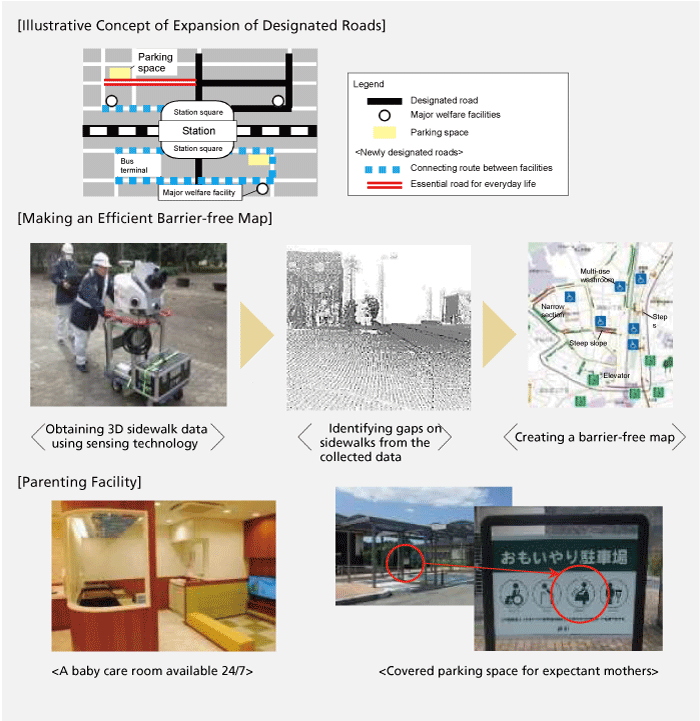
History of Traffic Safety Measures: Relevant Legislation, Organization and Policy (PDF)

New Approaches to Reduce Road Traffic Accidents in Japan (PDF)
Traffic Safety(6-9)
6. Development of better cyclist environment
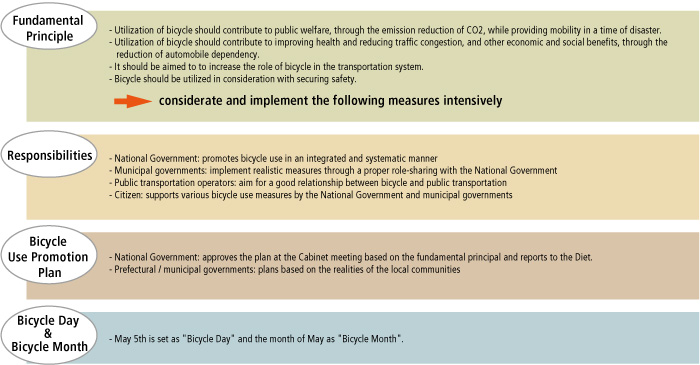
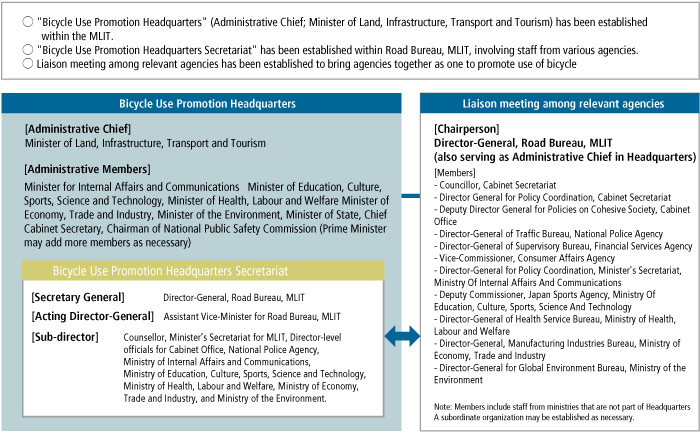
7. Improving Safety of Expressways
Background/data
-40% of expressways in Japan have 3 lanes or less, which is internationally rare. In 1992, Korea decided not to accept tentative 2 lanes from the viewpoint of safety. (Percentage of sections with 3 lanes or less: 44% in 1995 => 0% in 2015)
-There are 2 times as many fatal accidents on temporal 2-lane sections as other sections on expressways.
(Fatal accident rate*1 sections with 4 or more lanes: 0.15, sections with tentative 2 lanes :0.29)
*1 Expressways (tolled) (2013 to 2016)
-Of all tentative 2-lane sections on the tolled expressways, a total length of two-way traffic sections is about 1,600 km.
○We are committed to expanding the lanes to 4 lanes in order of precedence from the aspects of travel speed reduction, traffic safety and redundancy in addition to the sediment disaster-prone areas identified in the urgent inspection for the strategic infrastructure.
○Of these sediment disaster-prone areas on expressways as well as paralleling general roads, sections will be selected from the viewpoint of the past traffic restrictions, damages from disaster and traffic safety to be expanded from tentative 2 lanes to 4 lanes using fiscal investment and loan programs.
○In roughly 5 years (or 3 years for the sections managed by Expressway Companies (NEXCOs)), we will apply wire ropes to earthwork parts as an urgent countermeasure except for the expanding sections to 4 lanes.
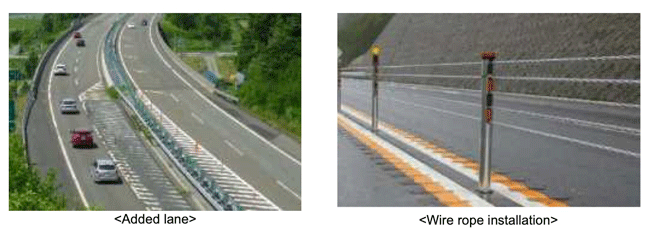
Background/data
-Future Investment Strategy 2018 (approved by the Cabinet on Jun 15, 2018) includes expansion of Shin Tomei Expressway to 6 lanes and other measures for improve freight efficiency.
○6-lane Shin Tomei Expressway will provide improved redundancy and efficiency of the link between the three major metropolitan areas, and secure a reliable connection in a disaster.
○We have started with to a high-priority section in Shizuoka Prefecture between Gotenba JCT and Hamamatsu-inasa JCT*2), which would pose a problem if Tomei Expressway is closed in a disaster.
○Using the fiscal investment and loan program, we have expanded a section of Shin-Meishin Expressway (Kameyama-nishi JCT - Otsu JCT) to 6 lanes*3 .
*2 Almost the entire section has been expanded to 6 lanes.
*3: we have also added a lane in Hirakata Tunnel for congestion mitigation.
Background/data
-FY2017 saw 207 wrong-way driving, 60% of which occurred at ICs and JCTs.
-Wrong-way driving increases a chance of causing fatal and injury accident by 5 times and fatal accident by 40 times.
-45% of wrong-way drivers are over the age of 75 (Jan 2011 to Jan 2017)
-Improvements at merging points and exit points are almost complete, reducing the number of accidents by 30%.
○We will continually install road sign posts and road markings to warn wrong-way driving.
○At the locations with the past wrong-way driving incidents, we use innovative technologies selected among proposals from the public.
○We also provide special measures allowing wrong-way drivers to turn around* for safety and guidance.
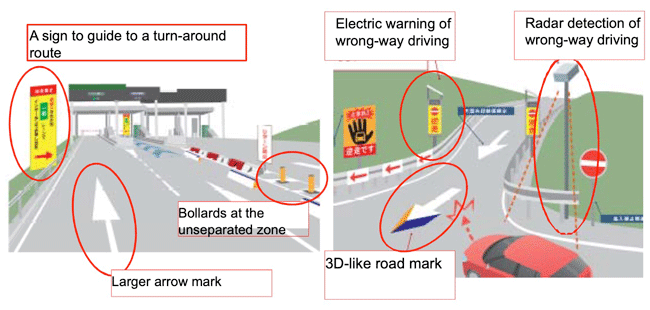
Background/data
-An increased number of pedestrians unintentionally enter expressways. (from 2,600 cases in FY2011 to 3,700 cases in 2017)
Violators are most often see in the age groups of 20s (22%) and 70s (14%).
Under 20% of the trespassers to Tokyo Metropolitan Expressway used a navigation app.
(from April 2017 to Mar 2018)
○Installation of warning signs, soft-hit posts, and colored pavement contributed a reduction of unintentional entries. We will continue to take effective actions by analyzing how unintentional entries occur.
○We will work with navigation app providers to provide warning in the app by sharing the data of unintentional entries and designation of highways for exclusive use of automobiles.
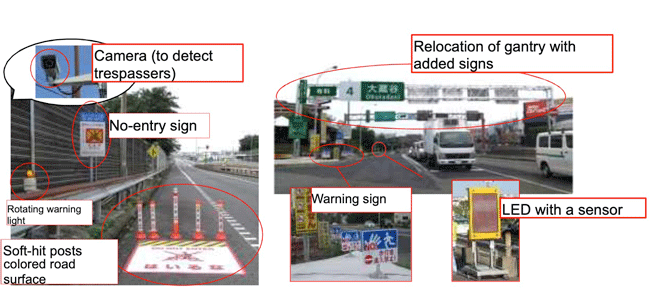
Background/data
-We are facing an increasingly severe shortage of parking spaces for HGV drivers who use expressways as the main freight route and require parking spaces for long hours.
(example) 55% of total parking * are made by long-hour users who park over 6 hours at Ebina Service Area.
* total parking = number of parked vehicles x parking duration
-The standard for the improved working hours of truck divers require a rest every 4 hours of driving.
In addition to increasing the parking spaces at resting areas, we will
i) arrange parking spaces serving both passenger cars and HGVs
ii) allow ETC2.0 users to temporarily exit expressway to use resting areas.
iii) introduce booking system for parking space
iv) provide detailed information of availability to level off the usage
v) ban long-hour parking
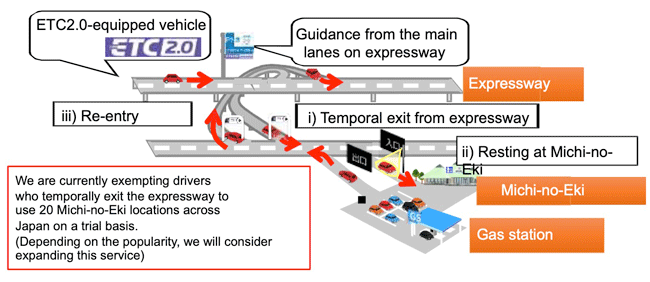
-While free expressways will be rapidly developed in the future, resting areas are not sufficiently offered.
-Free expressways: Currently 2,238 km (as of Dec 2018) => 3,300 km in the future (after all under-construction sections are completed)
Working with local communities, we guide drivers to "Michi-no-Eki" near an IC on general road to provide a resting service.
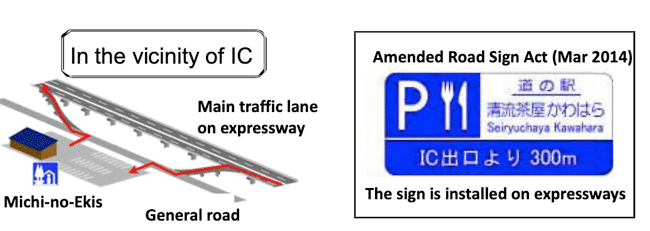
We are engaged in manning the uncrewed parking areas and improve their service levels by working with local communities to make the locations active.
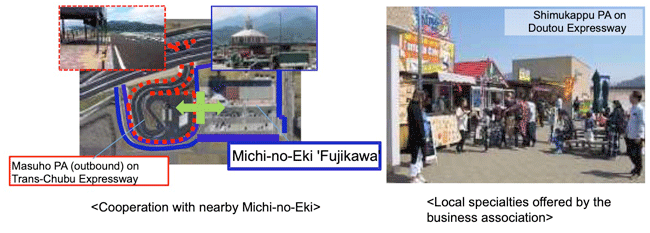
8. Safety Improvement for Residential Streets and School Routes
Background/data
-FY2018 saw a traffic death toll of 3,532 which was even lower than the lowest number recorded in 2017 and since 1948. (NPA)
-Fatalities of drivers per population of 100,000 are the lowest in the G-7 countries, while fatalities of pedestrians/cyclists are the highest*18.
-Half of fatal pedestrian/cyclist accidents occurred within 200 m from their homes (FY2017)
-Designation of strategic areas for traffic safety improvement of residential streets: 498 areas in 293 municipalities (End of Jul 2018) => 806 areas in 391 municipalities(End of Dec 2018)
○We are expanding "strategic areas for traffic safety improvement of residential streets" using big data to reduce traffic speed and through-traffic.
○We will support continual implementation of the PDCA cycle based on the "Safe school road program"*19
○We are considering advance collection and utilization of big data (effective installation of mobile roadside units and measurement methods to capture pedestrian behavior).
○To create an environment where drivers will unconsciously be alert to pedestrians and cyclists, we are discussing ideal road space and collecting case studies of coexistence and harmonization between motorists and non-motorists.
Note *18: fatalities per a population of 100,000 (2015) [Drivers] Highest: 1.2 (Japan), Lowest: 7.5 (U.S.) [Pedestrians/cyclists] Highest: 0.8 (UK), Lowest; 2.0 (Japan)*19: developed by schools, school boards, road administrators, and the police in a cooperative manner. As of the end of Mar 2017, 1,605 municipalities have developed a program.
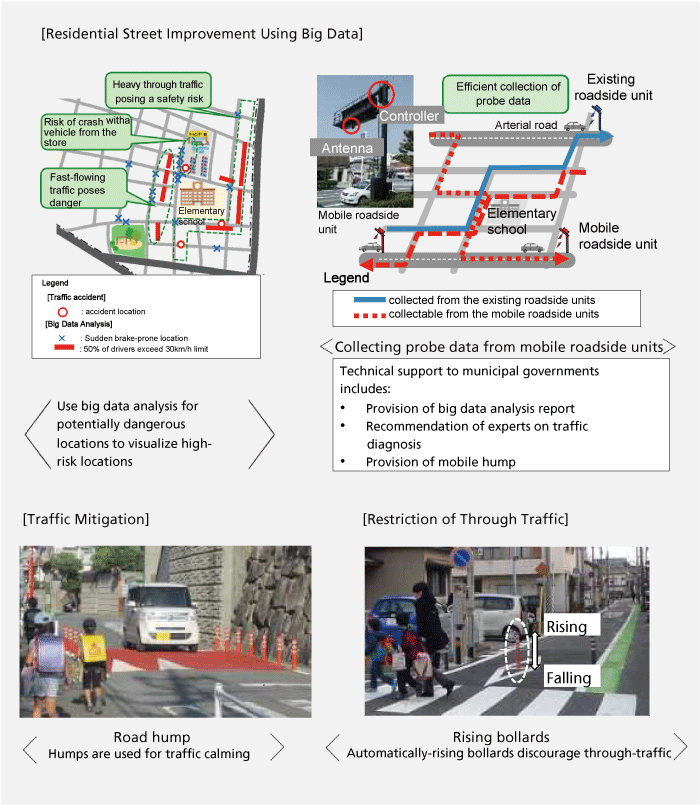
9. Promotion of Universal Design
Background/data
-90% of the designated roads based on the "Barrier-free Act" have been universally designed. This percentage drops to 60% in the areas near a Yamanote Line station when it includes other roads. (FY2017)
-The amendment of the "Barrier-free Act" (when provision of information about barrier-free design became obligatory) was enacted on May 18, 2018
-Development of parenting support facilities at Service Areas occurred on expressways and Michi-no-Ekis

○To promote area-wide universal design near major area stations, we have added more designated roads*24.
○To make barrier-free sidewalk maps efficiently, we are obtaining digital road map data using sensing technology.
○We are developing 24/7 baby corners and other parenting facilities at Service Areas on expressways and Michi-no-Ekis developed by the MLIT and will complete them in roughly 3 years.
